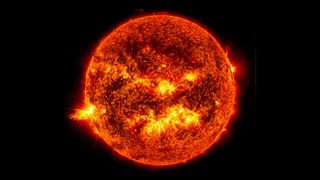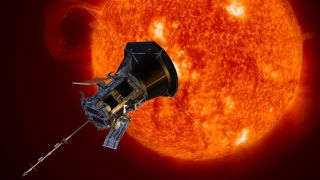How hot is the sun?
Temperatures vary between different layers. So just how hot is the sun?

Life on Earth would not exist without our huge hot glowing ball of gas. But just how hot is the sun? Well, that depends…
The temperature of the sun varies from around 27 million degrees Fahrenheit (15 million degrees Celsius) at the core to only about 10,000 degrees F (5,500 degrees C) at the surface, according to NASA.
Every 1.5 millionths of a second, the sun releases more energy than all humans consume in an entire year according to NASA Space Place. Here, we explore how hot each layer of the sun is and why the temperatures vary so much.
Related: When will the sun die?
Where does the sun's heat come from?
The sun is made of gas and plasma. Most of the gas — 92% — is hydrogen. If the sun were smaller, it would just be a huge ball of hydrogen akin to Jupiter. According to NASA Space Place, the hydrogen in the sun's core is held together by a lot of gravity resulting in high pressure. The pressure is so high that when hydrogen atoms collide with enough force they create a new element — helium — in a process called nuclear fusion.
The continual nuclear fusion, causes energy to build up and the sun's core reaches temperatures of about 27 million degrees F (15 million degrees C). The energy then radiates outward to the sun's surface, atmosphere and beyond.
Radiative zone temperatures
Outside the sun's core lies the radiative zone where temperatures range from 12 million degrees F (7 million degrees C) nearest the core to around 4 million degrees F (2 million degrees C) in the outer radiative zone, according to the educational website Study.com. No thermal convection occurs in this layer, according to the science news website Phys.org. Instead, heat is transferred via thermal radiation whereby hydrogen and helium emit photons that travel a short distance prior to getting reabsorbed by other ions. It can take light particles (photons) thousands of years to meander their way through this layer before reaching the surface of the sun.
Convection zone temperatures
Beyond the radiative zone is the sun's convective zone which extends for 120,000 miles (200,000 kilometers) according to Study.com. Temperatures in the convection zone are approximately 4 million degrees F (2 million degrees C). Plasma in this layer moves in a convective motion — like boiling water — bubbles of hot plasma transport heat to the surface of the sun.
The sun's atmosphere: Photosphere, chromosphere and corona temperatures

Temperatures in the sun's atmosphere also vary considerably between the layers. In the photosphere, temperatures reach about 10,000 degrees F (5,500 degrees C) according to the educational website The Sun Today. It is here that the sun's radiation is detected as visible light. Sunspots on the photosphere appear dark because they are cooler than the other parts of the sun's surface. The temperature of sunspots can be as low as 5,400 to 8,100 degrees F (3,000 to 4,500 degrees C) according to the University Corporation of Atmospheric Research (UCAR).
The chromosphere lies above the photosphere and temperatures range from approximately 11,000 degrees F (6,000 degrees C) nearest the photosphere to about 7,200 degrees F (4,000 degrees C) a couple of hundred miles higher up.
Now here is where things get a little bit strange. Above the chromosphere lies the corona — the outermost layer of the sun's atmosphere. The sun's corona extends thousands of miles above the visible "surface" (photosphere) of the sun. Now you might think that temperatures here must be the lowest here since we are the farthest away from the heat-generating core… but that isn't the case. At all.
The sun's corona can reach temperatures of around 1.8 million degrees F to 3.6 million degrees F (1 to 2 million degrees C), that's up to 500 times hotter than the photosphere. But how is the sun's upper atmosphere hotter than the surface? It's a great question, and one that has scientists rather stumped. There are some ideas about where the energy comes from that heats the corona, but a definitive conclusion is yet to be made. If you'd like to read more about this solar mystery check out this article on "Why is the sun's atmosphere hotter than its surface?".
Sun temperature FAQs answered by an expert
We asked Jia Huang, solar researcher at UC Berkeley's Space Sciences Laboratory, a few frequently asked questions about the sun.

Jia Huang is an assistant researcher at the Space Sciences Laboratory of the University of California Berkeley, whose current work focuses on investigating the solar wind and data from NASA's Parker Solar Probe.
How do we know the temperature of the sun?
In my opinion, we know the temperature of the sun in two ways: theory and observation. Theoretically, we can estimate the temperatures of various solar layers by considering the underlying physical processes.
Observationally, we can directly measure the temperatures of the layers above the photosphere (including photosphere, chromosphere, transition region, and corona) either with remote telescopes (we can derive the temperatures based on spectroscopic data) or with in-situ instruments onboard spacecraft (a method applies only to the solar corona when Parker Solar Probe enters it).
Why does the temperature of the sun vary so much?
The temperature of the sun relates to the generation, transport, and dissipation of energies. The distinct physical processes occurring in various layers of the sun lead to considerable energy fluctuations, causing the wide range of temperatures observed throughout the sun.
Where are the highest temperatures of the sun found?
The core of the sun has the highest temperature, approximately 10 million Kelvin, as a result of the incessantly thermonuclear fusion processes that produce the energy the sun relies on. In general, the temperature decreases from the core to the photosphere and then increases towards the corona; however, the abnormally high temperature of the corona (~1 million kelvin) is still a mystery. One interesting thing is that some colleagues compare the sun to fried ice cream, indicating the solar corona is much hotter than the solar surface, but this is not very accurate because the core of the sun is the hottest.
The Parker Solar Probe
The Parker Solar Probe, launched in August 2018, is currently orbiting and observing our star. One of its aims is to investigate why the corona defies stellar dynamic models by having a temperature greater than the photosphere.
The craft flies through the sun's atmosphere, withstanding violent temperatures, often coming as close to its surface as 3.8 million miles (6.1 million kilometers). As it does this it will collect measurements of the corona and essential data on solar winds, also taking images of the star.
In 2021 the probe became the fastest craft created by humans, passing the sun at 364,621 mph (692,018 kph). When it is closest to the sun, the Parker Solar Probe travels at 430,000 mph (700,000 kph), according to NASA's Parker Solar Probe page.

how does our sun's temperature compare to other stars?
Stars come in a variety of sizes and colors so it should be no surprise that they have different temperatures too. Astronomers can tell a lot about the temperature of a star by its color, or its spectral type.
There are 7 spectral types designated by the letters O, B, A, F, G, K, and M. The hottest stars are O and B stars which shine mostly blue light with a great deal of their light in the ultraviolet spectrum. M-type stars are the coolest class more prominent in red wavelengths but also emitting a lot of infrared light.
Blue stars have estimated surface temperatures of 25,000 kelvin (K) (44,540 degrees F/ 24,726 degrees C), while red stars are much cooler at around 3,000 K (4,940 degrees F/ 2,726 degrees C), according to the University of Central Florida. In between these are white stars with temperatures of around 10,000 K (17,540 degrees F/ 9,726 degrees C), yellow stars, like the sun, at 6,000 K (10,340 degrees F/ 5,726 degrees C), and cooler orange stars with temperatures in the region of 4,000 K (6,740 degrees F/ 3,726 degrees C).
Additional resources
You can explore the sun in more detail with NASA's Solar Dynamics Observatory or keep up to date with the latest findings from NASA's Parker Solar Probe on its mission to "touch" the sun. If you want to improve your knowledge and understanding of the sun check out this free course courtesy of the Open University. Read about energy from the sun and how we can make use of it in this informative guide from the National Energy Education Development Project (NEED).
Bibliography
- Aschwanden, Markus J. "The Quiet-Sun Corona." New Millennium Solar Physics. Springer, Cham, 2019. 219-259.
- Stangalini, Marco, et al. "Torsional oscillations within a magnetic pore in the solar photosphere." Nature Astronomy (2021): 1-6.
- "The Sun's atmosphere is hundreds of times hotter than its surface — here's why", The Conversation.
- "Color of Stars". University of Central Florida. Astronomy UCF Pressbooks.
Join our Space Forums to keep talking space on the latest missions, night sky and more! And if you have a news tip, correction or comment, let us know at: community@space.com.
Get the Space.com Newsletter
Breaking space news, the latest updates on rocket launches, skywatching events and more!

Daisy Dobrijevic joined Space.com in February 2022 having previously worked for our sister publication All About Space magazine as a staff writer. Before joining us, Daisy completed an editorial internship with the BBC Sky at Night Magazine and worked at the National Space Centre in Leicester, U.K., where she enjoyed communicating space science to the public. In 2021, Daisy completed a PhD in plant physiology and also holds a Master's in Environmental Science, she is currently based in Nottingham, U.K. Daisy is passionate about all things space, with a penchant for solar activity and space weather. She has a strong interest in astrotourism and loves nothing more than a good northern lights chase!
- Robert LeaSenior Writer